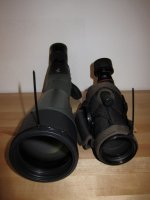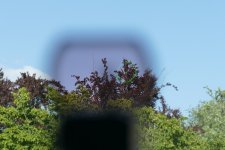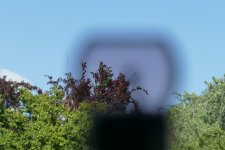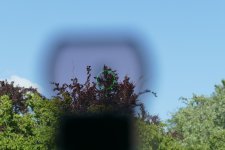Hi everyone,
After trying a red dot sight (also known as reflex or reflector sight) on my Nikon ED50A both from a tripod and when held in the hand, I'm pretty enthusiastic about the technology!
Here is a picture of my test rig. It combines a "flash grip" mounted between tripod and scope base by means of a tripod screw with a hotshoe-to-Weaver mount, on which the reflex sight is mounted (with an extra Weaver-to-dovetail adapter).
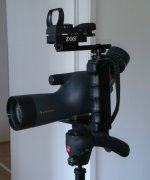
The "flash grip" was a cheap collapsible one the local photo dealer had in stock. The hotshoe-to-Weaver mount is the all-metal Xtendasight from Photosolve:
https://photosolve.com/main/product/xtendasight/index.html
Photosolve also offers the Weaver-to-dovetail adapter, but due to the confusing rail designations (in Imperial units) I missed that opportunity and later bought an equivalent adapter locally.
The reflex sight is a cheap one from Amazon, but I'm really pleased both with the features and the quality. It offers different reticles and, importantly, green illumination (which shows much better against a bright, sunny background). Had I understood the mounting rails better, I'd probably have bought the Weaver rail version instead of the dovetail one:
https://www.amazon.de/Cvlife-1x22x33-Leuchtpunkt-Zielvisier-Holographic/dp/B00IODSYTO
Since reflex sights are sometimes confused with laser pointers, probably because of the "red dot" in their popular name: Reflex sights do not shine a laser at the target, but they only project the image of the reticle (a dot, crosshairs, a dot in a circle, etc.) on a piece of glass in front of the eyes of the observer. This image is focussed at infinity (for easy viewing) and overlays the target. Within a cone behind the sight, it's possible to move the eye around and still see the reticle on target - which makes a reflex sight much more convenient than "iron sights", like a ring-and-bead sight.
Overall, I'm really thrilled with the ease of use of the scope with reflex sight attached. It's really point-and-view for all stationary targets, with the scope being on target pretty much every time. When not using a tripod, I found that it was also surprisingly easy to acquire birds in flight by putting the dot on them (or a little in front) and then switchng to the eyepiece. This worked even for common snipes in display flight overhead, which I thought was a tough situation, especially considering I was using an angled scope (and high magnification).
However, the rig itself turned out to be a bit on the bulky side and not stiff enough. Transporting it in the backpack without disassembly meant the sight was usually off target after a while, and disassembling and mounting it to the scope again also meant that it was off the target. This was owed to the flash grip being somewhat flexible, collapsible, cheap, and mounted with a tripod screw - which gives no positive repeatable alignment.
One benefit of using a reflex sight that might not be immediately evident is that it works both ways - not only can you put the scope on target, you can also easily locate a target's surroundings if you have spotted a bird while panning. Even better, it's fairly easy to let someone else have a look through the reflex sight to understand where to point his (or hers) own scope to pick up the bird you have spotted. This works a lot better than peeking through the scope, which in many environments (such as vast meadows, or tidal flats) often doesn't help too much unless by chance the bird is sitting in front of a unique landmark.
I've read that other people have tried reflex sights on their spotting scopes too, and I'd be interested in your experience!
I've also found a ten years old thread on this board which even included photographs of the scopes with the sights in place, which I found very interesting, but unfortunately these photographs didn't show much detail. If you'd like to share a picture of your installation, that would be much appreciated!
Regards,
Henning
After trying a red dot sight (also known as reflex or reflector sight) on my Nikon ED50A both from a tripod and when held in the hand, I'm pretty enthusiastic about the technology!
Here is a picture of my test rig. It combines a "flash grip" mounted between tripod and scope base by means of a tripod screw with a hotshoe-to-Weaver mount, on which the reflex sight is mounted (with an extra Weaver-to-dovetail adapter).

The "flash grip" was a cheap collapsible one the local photo dealer had in stock. The hotshoe-to-Weaver mount is the all-metal Xtendasight from Photosolve:
https://photosolve.com/main/product/xtendasight/index.html
Photosolve also offers the Weaver-to-dovetail adapter, but due to the confusing rail designations (in Imperial units) I missed that opportunity and later bought an equivalent adapter locally.
The reflex sight is a cheap one from Amazon, but I'm really pleased both with the features and the quality. It offers different reticles and, importantly, green illumination (which shows much better against a bright, sunny background). Had I understood the mounting rails better, I'd probably have bought the Weaver rail version instead of the dovetail one:
https://www.amazon.de/Cvlife-1x22x33-Leuchtpunkt-Zielvisier-Holographic/dp/B00IODSYTO
Since reflex sights are sometimes confused with laser pointers, probably because of the "red dot" in their popular name: Reflex sights do not shine a laser at the target, but they only project the image of the reticle (a dot, crosshairs, a dot in a circle, etc.) on a piece of glass in front of the eyes of the observer. This image is focussed at infinity (for easy viewing) and overlays the target. Within a cone behind the sight, it's possible to move the eye around and still see the reticle on target - which makes a reflex sight much more convenient than "iron sights", like a ring-and-bead sight.
Overall, I'm really thrilled with the ease of use of the scope with reflex sight attached. It's really point-and-view for all stationary targets, with the scope being on target pretty much every time. When not using a tripod, I found that it was also surprisingly easy to acquire birds in flight by putting the dot on them (or a little in front) and then switchng to the eyepiece. This worked even for common snipes in display flight overhead, which I thought was a tough situation, especially considering I was using an angled scope (and high magnification).
However, the rig itself turned out to be a bit on the bulky side and not stiff enough. Transporting it in the backpack without disassembly meant the sight was usually off target after a while, and disassembling and mounting it to the scope again also meant that it was off the target. This was owed to the flash grip being somewhat flexible, collapsible, cheap, and mounted with a tripod screw - which gives no positive repeatable alignment.
One benefit of using a reflex sight that might not be immediately evident is that it works both ways - not only can you put the scope on target, you can also easily locate a target's surroundings if you have spotted a bird while panning. Even better, it's fairly easy to let someone else have a look through the reflex sight to understand where to point his (or hers) own scope to pick up the bird you have spotted. This works a lot better than peeking through the scope, which in many environments (such as vast meadows, or tidal flats) often doesn't help too much unless by chance the bird is sitting in front of a unique landmark.
I've read that other people have tried reflex sights on their spotting scopes too, and I'd be interested in your experience!
I've also found a ten years old thread on this board which even included photographs of the scopes with the sights in place, which I found very interesting, but unfortunately these photographs didn't show much detail. If you'd like to share a picture of your installation, that would be much appreciated!
Regards,
Henning






